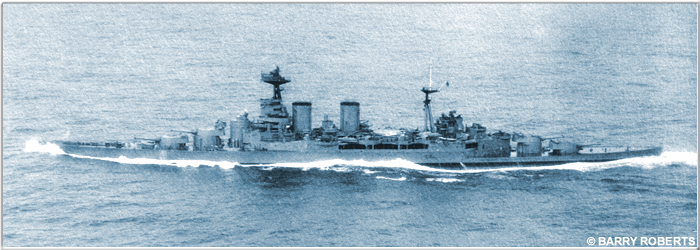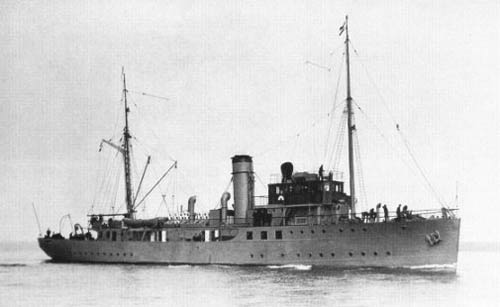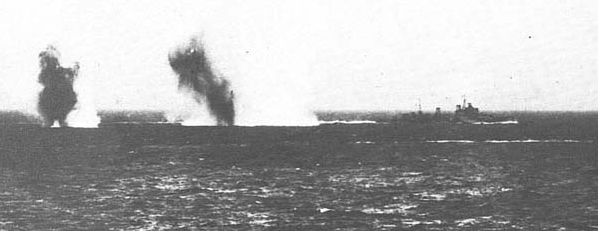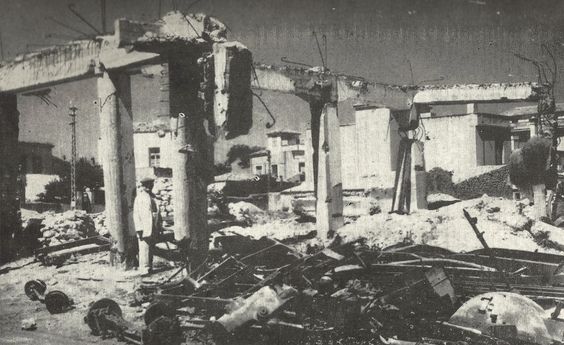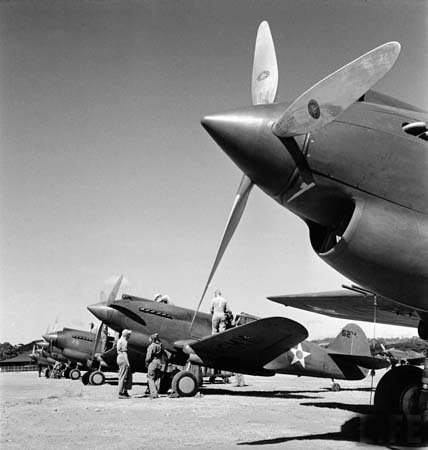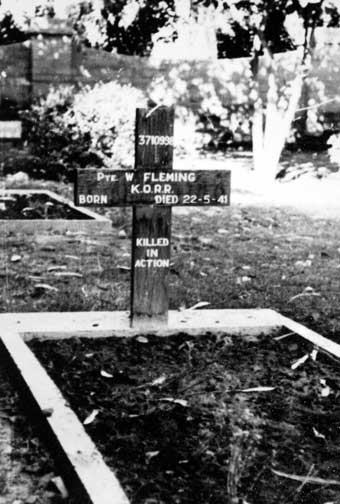Saturday 24 May 1941
 |
| "Shell splashes from British Battleship HMS PRINCE OF WALES fall short of their target the German Heavy Cruiser PRINZ EUGEN." 24 May 1941. © IWM (HU 383). |
In preparation for the upcoming invasion of Syria, British commandos dynamite a bridge along the Aleppo-Mosul railway. A train arrives in Mosul carrying Vichy supplies from the Vichy forces in Syria.
HMAS Yarra (CMDR W. H. Harrington, RAN) attacks Habib Shawi. It lands some Gurkha troops which pacify the position, then re-embark. The Yarra also has a shore party ashore to map out the terrain for a future large-scale British invasion of Iraq.
Middle East Commander General Archibald Wavell confers with British Indian commander Claude Auchinleck in Basra, Syria.
East African Campaign: The Allied forces (11th and 12th African Divisions) take Soddu, Abyssinia. General Gazzera leads weak Italian forces in the area.
European Air Operations: The RAF has planes out searching for battleship Bismarck and cruiser Prinz Eugen.
 |
| "German Battleship BISMARK engaging the British Battlecruiser HMS HOOD as seen from the German Heavy Cruiser PRINZ EUGEN" © IWM (HU 386). |
Suffolk acts quickly and signals its position to other very powerful Royal Navy units approaching from the southeast. Battleship Prince of Wales and battlecruiser Hood on their way from Scapa Flow sail right by the German ships without spotting them due to poor visibility.
Prince of Wales and Hood are 35 miles away and now from the Bismarck and Prinz Eugen and now, because of the temporary loss of contact, must chase them. Finally, at 05:35, the lookouts on the Prince of Wales spot the German ships. The Germans also spot the British around this time, alerted by their hydrophonic sensors. Admiral Lancelot Holland, aboard the Hood, decides not to wait for reinforcements and gives the order to close and open fire. This is the Battle of Denmark Strait.
Hood opens fire at 05:52 at the extreme distance of 26,500 years (24,200 meters). The British mistake the lead ship to be the Bismarck, but Admiral Günther Lütjens aboard the Hood has put the Prinz Eugen in the lead due to the loss of the Bismarck's forward radar on the 23rd. For at least the opening stages, Hood fires on Prinz Eugen while Prince of Wales fires on Bismarck. Norfolk and Suffolk are too far away to participate.
The Prince of Wales has mechanical issues with its main guns - the only ones it can use at this distance - and the front three (of nine total) fall silent after the first salvo. Workmen from Scapa Flow are aboard and continue working on them throughout the battle.
The weather conditions favor the Germans, as the wind is from the west. This causes difficulties on Hood and Prince of Wales in aiming their salvoes. However, Prince of Wales gets the first hit, disabling the Bismarck's commander's boat and seaplane catapult. It gets two more hits, the first passing clean through the Bismarck's bow without exploding, the third hitting below the Bismarck's waterline and causing flooding.
 |
| "A column of smoke rising above the sinking British Battlecruiser HMS HOOD. HMS PRINCE OF WALES in the background. This picture was taken from the German Heavy Cruiser PRINZ EUGEN" © IWM (HU 385). |
The German ships open fire at 05:55 after some discussion on the bridge of the Bismarck. Admiral Lütjens waits for better conditions, but finally, Bismarck Kapitän zur See Ernst Lindemann ends the debate: "Ich lasse mir doch nicht mein Schiff unter dem Arsch wegschießen. Feuererlaubnis!" ("I'm not letting my ship get shot out from under my arse. Open fire!"). Lütjens then orders Prinz Eugen Kapitän zur See Helmuth Brinkmann to open fire as well. Both Bismarck and Prinz Eugen concentrate on Hood, and they score one minor hit on the Hood's boat deck, and then another at the base of the bridge.
At 06:00, Admiral Holland orders a turn to port for both British ships to bring the aft main guns into action. The distance at this point has closed to about nine miles (14 km). A salvo from Bismarck then straddles the Hood, with one hit around the mainmast that apparently ignites the aft magazine. The Hood immediately blows up in a fireball of such force that it blows the two massive aft turrets into the sea. Hood breaks in two and sinks in three minutes. There are three survivors out of 1419 men.
Prince of Wales almost runs over the rapidly disappearing Hood, but an abrupt change, of course, avoids a collision. Both German ships now focus on the Prince of Wales, with one hit by the Bismarck and three by the Prinz Eugen. Two of the shells fail to explode, but minor flooding results that also releases some fuel oil. The problems with the guns put more out of action, and at 06:04 Captain John Leach decides to withdraw with 13 dead and nine wounded.
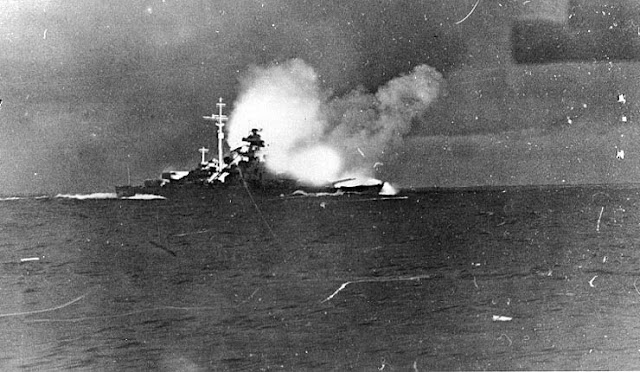 |
| Bismarck firing on Hood and Prince of Wales, Battle of Denmark Strait, 24 May 1941, photographed from Prinz Eugen. |
Lindemann's men try to repair the damage from the Battle of the Denmark Strait, but they fail completely. He has to shut down Boiler Room No. 2, and this reduces the ship's speed to a still fast 28 knots. Bismarck now no longer has enough fuel for a raiding mission, so Lütjens decides to head for France - rather than Norway, which is closer. Once again Lütjens overrules Lindemann, who wants to return to Bergen. Since Prinz Eugen is undamaged, Lütjens detaches it for an independent raiding mission while he sets a course for the French port of Saint-Nazaire.
In Berlin, Admiral Raeder learns of Lütjens' decision from wireless messages and, after much back-and-forth with his staff, calls Adolf Hitler in Berchtesgaden. Hitler says to those with him:
If now these British cruisers are maintaining contact and Lütjens has sunk the Hood and nearly crippled the other, which was brand new and having trouble with her guns during the action, why didn't he sink her too? Why hasn't he tried to get out of there or why hasn't he turned around?Basically, Hitler sides with Lindemann on both issues of dispute between him and Lütjens. It is easy to question Lütjens' decisions, but he has the entire Royal Navy and RAF after him, and he really has no good choices far from home with a damaged ship.
Radio Berlin announces the sinking of the Hood in the evening to wild acclaim, but witnesses report that Hitler is not happy, but rather very worried about Bismarck's prospects.
 |
| HMS Prince of Wales, prior to 24 May 1941. |
 |
| "British Battlecruiser HMS HOOD exploding (right) and the British Battleship HMS PRINCE OF WALES (center) as seen from the German Heavy Cruiser PRINZ EUGEN." © IWM (HU 384). |
Intend to shake stalker as follows: During rain squall, the BISMARCK will change course west. PRINZ EUGEN will maintain course and speed until he is forced to change position or three hours after the departure of Bismarck. Subsequently, is released to take on oil from "Belchen" or "Lothringen". Afterwards, pursue independent cruiser war. Implementation upon cue word, "Hood."
Bismarck continues running for France, while Prinz Eugen escapes unobserved to the west.
The Admiralty redirects large warships to hunt down Bismarck. This includes battleship HMS Rodney.
US Navy Patrol Squadron 52 (VP-52) at Naval Air Station Argentia, Newfoundland sends its eleven PBY-5 Catalina Flying Boats (serviced by seaplane tender USS Albemarle) off in fierce weather to search for Bismarck and Prinz Eugen.
U-103 (KrvKpt. Viktor Schütze), on its fourth patrol out of Lorient and operating off Freetown, sinks 3575-ton Egyptian freighter Radames. This follows a long chase that began at 17:50 on the 23rd. It takes three torpedoes, the first two of which miss.
U-38 (Kptlt. Heinrich Liebe), on its ninth patrol out of Lorient, is operating off Freetown when it torpedoes and sinks 4362-ton British freighter Vulcain.
British 2034-ton tanker Octane hits a mine in the English Channel and is beached near Anthony. The ship is later repaired at Falmouth.
The Luftwaffe bombs and sinks 2846-ton Greek freighter Matronna at Milford Haven. Everyone survives.
The Luftwaffe bombs and damages 711-ton British freighter Sarnia while at anchor at Milford Haven. The freighter is towed to Milford Docks for repairs.
The Luftwaffe bombs and damages 4270-ton British freighter Cressdene in Mumbles Roads.
U-433 (Oberleutnant zur See Hans Ey) and U-752 (Kapitänleutnant Karl-Ernst Schroeter) are commissioned, U-505 and U-702 are launched, U-446 is laid down.
German raider Atlantis, disguised as Dutch freighter Brastagi, sinks 4530-ton British collier Trafalgar (which also carries two aircraft) off Namibia in the South Atlantic. There are 12 deaths and 33 crew are taken aboard the Atlantis.
 |
| "A shell from the British Battlecruiser HMS HOOD lands near the German Battleship BISMARK forming a large white column of water. The black smoke near BISMARCK indicates it has just fired a salvo on the British warships." © IWM (HU 382). |
The operations of the last four days have been nothing short of a test of strength between the Mediterranean Fleet and the German Air Force. I am afraid that, in the coastal area, we have to admit defeat and accept the fact that losses are too great to justify us in trying to prevent seaborne attacks on Crete. This is a melancholy conclusion, but it must be faced.If nothing else, this is final and decisive proof of the superiority of air power over naval power. Today, the real-life implications of the loss of naval control become evident.
The Germans begin expanding from their Maleme airfield lodgement in earnest today to the east. The Luftwaffe attacks Allied forces in Kastelli, near Heraklion, paving the way for the 95th Gebirgs Pioneer Battalion to take the town. Incidental to this attack, German paratroopers (Fallschirmjäger) who had been captured there following the initial landings on 20 May manage to escape by killing or capturing their captors (New Zealand officers of the 1st Greek Regiment). The Greek troops put up a fierce defense in the area that lasts for days, but they are low on ammunition and steadily pushed back. The Germans approach Canea.
The Germans make one last attempt at a seaborne landing. At Piraeus, Oberleutnant-zur-See Österlin, who had commanded the abortive landing attempt at the beginning of the invasion which the Royal Navy prevented, tries again. He puts two Panzer II tanks on a wooden lighter and sets out for Crete under tow from tug Kentauros. However, the Luftwaffe spots Royal Navy units nearby, so he aborts this attempt as well and puts in at the island of Kithira. Thus, the Germans on Crete continue to operate without armor, but the British there have only a handful of tanks, so this is not a major issue.
The British still hold Suda Bay. They use it today to land 200 commandos (A and D battalions of British Layforce) aboard fast minelayer Abdiel. The Abdiel then quickly turns around and departs. About 800 additional commandos are on destroyers offshore but cannot be landed due to bad weather.
The Australian 19th Infantry Brigade attacks the German 2nd Fallschirmjäger Regiment near Retimo. The Germans there are in purely defensive mode, as the entire German invasion focus is on Maleme.
 |
| Bismarck firing on Hood and Prince of Wales, Battle of Denmark Strait, 24 May 1941, photographed from Prinz Eugen. |
The special announcement about Crete should form your front-page story. Germany's is one of the boldest military strokes in world history and awakens the pride of the nation. It should be an occasion for emphatic political commentary. Above all, emphasize the contrast between Churchill's initial boastful remarks and the German reporting that began only when factual battle results could be truthfully reported.The British media, meanwhile, are much more circumspect about the battle and provide dramatic stories about massive losses on both sides. General Ismay, visiting Prime Minister Churchill at Chequers, notes in his memoirs that Churchill is "almost exclusively" interested in the chase of the German battleship Bismarck despite the situation on Crete being "critical."
About 16 miles south of Sicily, Royal Navy submarine HMS Upholder (Lt-Cdr Malcolm David Wanklyn) penetrates an Axis convoy and damages 4854 ton Vichy French tanker Capitaine Damiani. Upholder also torpedoes and sinks 18,500 ton converted troop ship Conte Rosso. The Conte Rosso sinks within 40 minutes. There are 2729 soldiers and crew on board, and roughly half (1300) perish. The escorts then force Wanklyn to submerge and survive 37 enemy depth charges. The Capitaine Damiani makes it to Naples under tow from tug Goliath. There is some question whether the Upholder makes both attacks on the 24th, one may take place on the 23rd.
The Luftwaffe raids Tobruk. It sinks 76-ton naval drifter Aurora II. While making a nightly run to the port, Royal Navy sloop Grimsby and the small freighter it is escorting are sunk as well.
Admiral Cunningham orders aircraft carrier HMS Formidable to prepare to go to sea. The Formidable is to head to the island of Scarpanto (Karpathos) and attack the Axis airfield there. This will be Operation MAQ3.
 |
| Bismarck firing on Hood and Prince of Wales, Battle of Denmark Strait, 24 May 1941, photographed from Prinz Eugen. |
Anglo/Irish Relations: According to the War Cabinet minutes, Prime Minister of Northern Ireland John Andrews informs Winston Churchill that the Ulster Unionist Council has approved conscription in Northern Ireland. Andrews tells Churchill that he should do "what His Majesty's Government in the United Kingdom thought was best for the Empire."
Anglo/Chinese Relations: Winston Churchill sends Chiang Kai-shek a fulsome telegram in which he states in part, "In our different spheres our two countries are fighting in the ranks of freedom against tyranny and aggression."
US Government: The US Congress passes a bill authorizing construction of 550,000 tons of auxiliary vessels for use by the US Navy.
German Military: The OKW sends trainloads full of troops east in preparation of Operation Barbarossa. This will continue from this point forward until the launch of Operation Barbarossa.
 |
| One of the last photographs taken of Hood from her consort HMS Prince of Wales, early morning of 24 May 1941. |
South African Government: Prime Minister Jan Smuts formally becomes a British Field Marshal.
Norwegian Homefront: The occupying German authorities begin arresting union representatives during the Norway Theater Strike.
British Homefront: "War Weapon Week" concludes, with proceeds of £124,000,000 toward purchases of military items.
American Homefront: The Gallup organization releases the results of a poll in the United States:
Do you think President Roosevelt has gone too far in his policies of helping Britain, or not far enough?The results are 59% "About right," 21% "Too Far," and 20% "Not Far Enough."
Future History: Robert Allen Zimmerman is born in Duluth, Minnesota. He begins forming bands while in high school, and in May 1960 he drops out of college and moves to New York. He develops a following in Greenwich Village clubs, changes his stage name to Bob Dylan, and releases his first album on 19 March 1962. As Bob Dylan, he becomes a major contributor to the '60s folk-rock scene. As of this writing, Bob Dylan remains active in the music business, with regular tours in the US and Europe.
 |
| Bismarck on 24 May 1941. |
May 1941
May 1, 1941: British Hold Tobruk
May 2, 1941: Anglo-Iraq War
May 3, 1941: Liverpool Hammered
May 4, 1941: Hitler Victory Speech
May 5, 1941: Patriots Day
May 6, 1941: Stalin In Command
May 7, 1941: May Blitz
May 8, 1941: Pinguin Sunk
May 9, 1941: U-110 Captured
May 10, 1941: Hess Flies Into History
May 11, 1941: The Hess Peace Plan
May 12, 1941: Tiger Arrives Safely
May 13, 1941: Keitel's Illegal Order
May 14, 1941: Holocaust in Paris
May 15, 1941: Operation Brevity
May 16, 1941: Blitz Ends
May 17, 1941: Habbaniya Relieved
May 18, 1941: Croatia Partitioned
May 19, 1941: Bismarck at Sea
May 20, 1941: Invasion of Crete
May 21, 1941: Robin Moore Sinking
May 22, 1941: Royal Navy Destruction Off Crete
May 23, 1941: Crete Must Be Won
May 24, 1941: Bismarck Sinks Hood
May 25, 1941: Lütjens' Brilliant Maneuver
May 26, 1941: Bismarck Stopped
May 27, 1941: Bismarck Sunk
May 28, 1941: Crete Lost
May 29, 1941: Royal Navy Mauled Off Crete
May 30, 1941: Sorge Warns, Stalin Ignores
May 31, 1941: British Take Baghdad
2020












